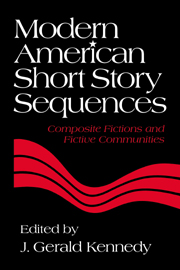Book contents
- Frontmatter
- Contents
- Contributors
- Introduction: The American Short Story Sequence – Definitions and Implications
- Henry James's Incipient Poetics of the Short Story Sequence: The Finer Grain (1910)
- Toomer's Cane as Narrative Sequence
- Hemingway's In Our Time: The Biography of a Book
- Wright Writing Reading: Narrative Strategies in Uncle Tom's Children
- The African-American Voice in Faulkner's Go Down, Moses
- Meditations on Nonpresence: Re-visioning the Short Story in Eudora Welty's The Wide Net
- Nine Stories: J. D. Salinger's Linked Mysteries
- Cheever's Shady Hill: A Suburban Sequence
- John Updike's Olinger Stories: New Light Among the Shadows
- Louise Erdrich's Love Medicine: Narrative Communities and the Short Story Sequence
- From Anderson's Winesburg to Carver's Cathedral: The Short Story Sequence and the Semblance of Community
- Index
Cheever's Shady Hill: A Suburban Sequence
Published online by Cambridge University Press: 29 September 2009
- Frontmatter
- Contents
- Contributors
- Introduction: The American Short Story Sequence – Definitions and Implications
- Henry James's Incipient Poetics of the Short Story Sequence: The Finer Grain (1910)
- Toomer's Cane as Narrative Sequence
- Hemingway's In Our Time: The Biography of a Book
- Wright Writing Reading: Narrative Strategies in Uncle Tom's Children
- The African-American Voice in Faulkner's Go Down, Moses
- Meditations on Nonpresence: Re-visioning the Short Story in Eudora Welty's The Wide Net
- Nine Stories: J. D. Salinger's Linked Mysteries
- Cheever's Shady Hill: A Suburban Sequence
- John Updike's Olinger Stories: New Light Among the Shadows
- Louise Erdrich's Love Medicine: Narrative Communities and the Short Story Sequence
- From Anderson's Winesburg to Carver's Cathedral: The Short Story Sequence and the Semblance of Community
- Index
Summary
Over the course of the previous half century, Vladimir Nabokov observed in November 1971, “the greatest Short Stories have been produced not in England, not in Russia, and certainly not in France, but in [the United States].” As examples, Nabokov went on to cite half a dozen personal favorites, with John Cheever's “The Country Husband” (1954) leading the list. Two years later, John Leonard declared his belief that “Cheever is our best living writer of short stories,” adding that this view was not commonly shared. With the publication of The Stories of John Cheever in 1978, however, everyone sailed their hats in the air. What the critics neglected to discover earlier, reading Cheever's stories singly in the New Yorker or in his smaller collections, suddenly became clear in the wake of this whopping assemblage of sixty-one stories. In fact, Cheever now deserved recognition, according to Stephen Becker, as “one of the two or three most imaginative and acrobatic literary artists” in the world.
One reason it took the critical establishment so long to respond to Cheever was his propensity toward short rather than long fiction. He himself addressed the question of story versus novel on several occasions during the 1950s, a decade that ended with the publication of his The Wapshot Chronicle (1957), a loosely organized episodic novel, and The Housebreaker of Shady Hill and Other Stories (1958), a coherently constructed story sequence. Simply for economic reasons, he understood that he must write novels. He also knew that a novel could do more than earn money: It could attract more serious attention than a book of stories. Circumstances proved the point.
- Type
- Chapter
- Information
- Modern American Short Story SequencesComposite Fictions and Fictive Communities, pp. 133 - 150Publisher: Cambridge University PressPrint publication year: 1995



